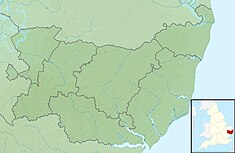| Revision as of 09:47, 25 December 2024 editKJP1 (talk | contribs)Autopatrolled, Extended confirmed users, New page reviewers, Pending changes reviewers, Rollbackers77,460 editsNo edit summary← Previous edit | Revision as of 09:48, 25 December 2024 edit undoKJP1 (talk | contribs)Autopatrolled, Extended confirmed users, New page reviewers, Pending changes reviewers, Rollbackers77,460 edits →HistoryNext edit → | ||
| Line 32: | Line 32: | ||
| The village of ] (alternatively Arwarton) is recorded in ]. The ] was held the D'Avillars, descending to the Calthorpes. The last of this line, Sir Philip Calthorpe, married ], becoming uncle-by-marriage of Queen ].<ref>{{NHLE|num=1193599|desc=Erwarton Hall Gatehouse|grade=I|access-date=25 December 2024}}</ref> Calthorpe died c.1549 and ] suggests that the Erwarton Gatehouse was built to commemorate his memory. | The village of ] (alternatively Arwarton) is recorded in ]. The ] was held the D'Avillars, descending to the Calthorpes. The last of this line, Sir Philip Calthorpe, married ], becoming uncle-by-marriage of Queen ].<ref>{{NHLE|num=1193599|desc=Erwarton Hall Gatehouse|grade=I|access-date=25 December 2024}}</ref> Calthorpe died c.1549 and ] suggests that the Erwarton Gatehouse was built to commemorate his memory. | ||
| Peter Ashley, in his study ''Comings and goings: Gatehouses and Lodges'' published in association with ], notes that while gatehouses have their origins in defensive architecture, they evolved from being "the first line of defence the first line in a style offensive".{{sfn|Ashley|2002|loc=Introduction}} The Erwarton Gatehouse belongs to the second type, ] suggesting that a strong central gate was never installed, and that the gatehouse |
Peter Ashley, in his study ''Comings and goings: Gatehouses and Lodges'' published in association with ], notes that while gatehouses have their origins in defensive architecture, they evolved from being "the first line of defence the first line in a style offensive".{{sfn|Ashley|2002|loc=Introduction}} The Erwarton Gatehouse belongs to the second type, ] suggesting that a strong central gate was never installed, and that the gatehouse has always stood in isolation without the encircling ] that would have been necessary to make it effective as a bar to encroachment.<ref>{{NHLE|num=1193599|desc=Erwarton Hall Gatehouse|grade=I|access-date=25 December 2024}}</ref> | ||
| ==Architecture and description== | ==Architecture and description== | ||
Revision as of 09:48, 25 December 2024
| This article is actively undergoing a major edit for a little while. To help avoid edit conflicts, please do not edit this page while this message is displayed. This page was last edited at 09:48, 25 December 2024 (UTC) (27 days ago) – this estimate is cached, update. Please remove this template if this page hasn't been edited for a significant time. If you are the editor who added this template, please be sure to remove it or replace it with {{Under construction}} between editing sessions. |
| Erwarton Hall and Gatehouse | |
|---|---|
 "in the first generation of English Renaissance architecture" "in the first generation of English Renaissance architecture" | |
| Type | House and gatehouse |
| Location | Erwarton, Suffolk |
| Coordinates | 51°58′12″N 1°14′06″E / 51.9701°N 1.2349°E / 51.9701; 1.2349 |
| Built | 16th century, with earlier origins and later additions |
| Architect | Sir Philip Parker |
| Architectural style(s) | Elizabethan architecture |
| Owner | Private |
| Listed Building – Grade I | |
| Official name | Erwarton Hall Gatehouse |
| Designated | 23 February 1989 |
| Reference no. | 1193599 |
| Listed Building – Grade II* | |
| Official name | Erwarton Hall |
| Designated | 23 February 1989 |
| Reference no. | 1351638 |
 | |
Erwarton Hall and Gatehouse stand to the north of the village of Erwarton, on the Shotley Peninsula in Suffolk, England. Although earlier structures stood on the site, the present hall was rebuilt in around 1575 by Sir Philip Parker. The gatehouse is earlier, dating to around 1549. The hall is a Grade II* listed building while the gatehouse is separately listed at Grade I.
History
The village of Erwarton (alternatively Arwarton) is recorded in Domesday. The lordship of the manor was held the D'Avillars, descending to the Calthorpes. The last of this line, Sir Philip Calthorpe, married Jane Boleyn, becoming uncle-by-marriage of Queen Anne Boleyn. Calthorpe died c.1549 and Nikolaus Pevsner suggests that the Erwarton Gatehouse was built to commemorate his memory.
Peter Ashley, in his study Comings and goings: Gatehouses and Lodges published in association with English Heritage, notes that while gatehouses have their origins in defensive architecture, they evolved from being "the first line of defence the first line in a style offensive". The Erwarton Gatehouse belongs to the second type, Historic England suggesting that a strong central gate was never installed, and that the gatehouse has always stood in isolation without the encircling curtain walls that would have been necessary to make it effective as a bar to encroachment.
Architecture and description
The hall is listed at Grade II* while the gatehouse is separately listed at Grade I.
Gallery
Footnotes
References
- Historic England. "Erwarton Hall Gatehouse (Grade I) (1193599)". National Heritage List for England. Retrieved 25 December 2024.
- Ashley 2002, Introduction.
- Historic England. "Erwarton Hall Gatehouse (Grade I) (1193599)". National Heritage List for England. Retrieved 25 December 2024.
- Historic England. "Erwarton Hall (Grade II*) (1351638)". National Heritage List for England. Retrieved 25 December 2024.
- Historic England. "Erwarton Hall Gatehouse (Grade I) (1193599)". National Heritage List for England. Retrieved 25 December 2024.
Sources
- Ashley, Peter (2002). Comings and goings: Gatehouses and lodges. London: Everyman Publishers. ISBN 978-1-841-59081-3.
- Bettley, James; Pevsner, Nikolaus (2015). Suffolk: East. Pevsner Buildings of England. New Haven, US and London: Yale University Press. ISBN 978-0-300-19654-2.
- Mowl, Timothy; Earnshaw, Brian (1985). Trumpet At A Distant Gate: The Lodge as Prelude to the Country House. London: Waterstone. ISBN 978-0-947-75205-7.
- Pevsner, Nikolaus; Enid, Radcliffe (1974). Suffolk. Pevsner Buildings of England. Harmsworth, Middlesex: Penguin Books. ISBN 978-0-140-71020-5.


